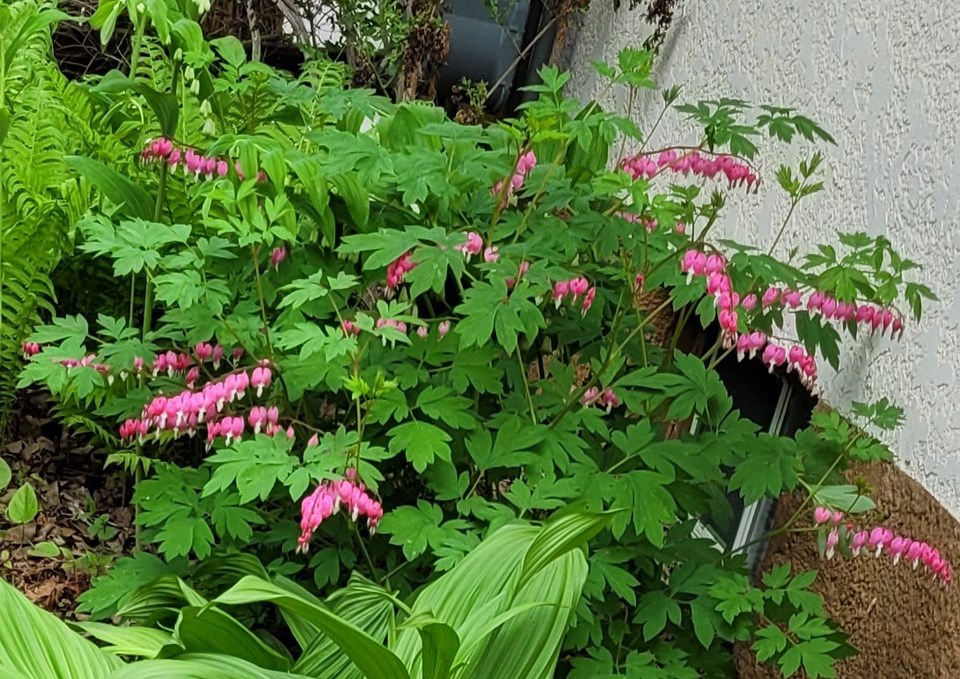An old-fashioned perennial, bleeding heart (Dicentra spp.) has graced prairie gardens for centuries. The common name refers to the heart-shaped flowers in shades of pink, red or white in which the inner petals protrude from the outer petals, resembling a "bleeding heart."
Ranging in height from 25-90 centimetres, they are characterized by attractive, ferny, deeply cut foliage and a graceful arching form. All are long-lived. They do best in full to partial shade in well-drained soil generously amended with organic matter. They do require even moisture but are otherwise low-maintenance and fit in well in a woodland or shade garden and a mixed border. Propagate them by early spring division.
Note that bleeding hearts contain isoquinoline alkaloids that are toxic to humans and animals (including dogs and cats), and have been known to eat them. It may cause skin irritation in sensitive individuals.
Fringed bleeding heart (D. eximia), native to the east coast of North America, is noted for its graceful arching form and ferny, compound, glaucous blue-green foliage. It is shorter (about 40 cm / 16 in.) and longer blooming than other species and does not become dormant in mid-summer.
Fernleaf bleeding heart (D. formosa) is very similar in appearance to the fringed bleeding heart but is native to the west coast of North America. Its foliage is a bit greyer and it will do okay in full sun as long as it has even moisture.
'Luxurient' (a hybrid of D. eximia and D. formosa) flowers through most of the summer with cherry- to rose-coloured blooms and a height of 40 cm (16 in.).
'Alba', 30 cm (12 in.) in height, has white flowers.
Common, Japanese or old-fashioned bleeding heart (Lamprocapnos spectablis, syn. D. spetabilis) is a close relative native to northern China, Korea and Japan. The plants are larger at 70-90 cm (30-36 in.) high, forming loose, bushy clumps and often become dormant with yellowing foliage in the heat of mid-summer. First brought to England in 1810, it failed to establish. It was reintroduced following a Royal Horticultural Society plant exploration trip in 1846 and soon became a common garden plant.
'Alba' is 60 to 90 cm (8 - 24 in.) tall with white flowers. It tolerates summer heat but is not as vigorous as other cultivars.
'Gold Heart' has pink flowers with golden foliage and is 90 cm (36 in.) tall.
'Valentine' has bright red flowers and is 70-90 cm (30-36 in.) in height.
The legend of the Bleeding Heart:
"Once upon a time, there was a man who fell in love with a beautiful, selfish princess. He wanted to convince her of his love, so he first bought her a pair of white rabbits (outer two petals flipped on the side). She took the gift but told him she did not love him.
Next, he offered her a pair of lovely shoes (inner two petals). She gladly took the gift but told him that she did not love him.
Alas, he decided to spend the rest of his money on a beautiful pair of earrings (two stamens) thinking she would alas realize his love for her. After accepting the gift he asked if she loved him. She laughed in his face and replied she could never love a penniless man.
Overcome with sadness, the man plunged a knife (anther) into his heart.
It is said that the first bleeding heart plant grew at that moment, showcasing his bleeding heart as a reminder of his tragical romance and unrequited love."
Holden Arboretum, Holden Forests and Gardens, Kirtland, Ohio
Sara Williams is the author and co-author of many books including 'Creating the Prairie Xeriscape', 'Gardening Naturally' with Hugh Skinner and, with Bob Bors, 'Growing Fruit in Northern Gardens.'
This column is provided courtesy of the Saskatchewan Perennial Society (SPS; [email protected]). Check our website () or Facebook page () for a list of upcoming gardening events.




